What is Frame Structure?
Framing is the process of mixing building materials to form the framework of a building. As a result, a framed structure uses beams, columns, and a slab to withstand gravity and other lateral loads. As a rule, these structures are employed to counteract the pressures and moments that emerge from the loading.
Characteristics of a Frame Structure:
- A-frame structure is a carefully arranged set of beams, columns, and slabs that can withstand the tremendous stresses and moments generated by severe gravity and lateral loads.
- They come together to form a framework of steel or concrete that supports the weight and transmits it to the ground without incident.
- In a framed structural system, walls are used to enclose the resulting cavity. There are two types of walls here: load-bearing and non-load-bearing. Shear walls make up the bulk of the framed building’s load-bearing walls.
- Pin or permanent connections join the frame’s structural parts.
- Consequently, beams, columns, slabs, and shear walls are a framed structure’s primary structural or load-carrying elements (load-bearing walls).
- The framework of a building may be fabricated from a wide variety of materials.
Types of Frame Structure:
A. Based on the connection between the elements of a frame structure:
1. Rigid Frame Structure:
Beams and columns are examples of the linear elements that make up a rigid frame system, also known as a moment frame system. Rigidity is the inability to bend or flex. It is commonly found in reinforced concrete and steel structures. Static indeterminacy is a hallmark of rigid frames, distinguished by the absence of pinned joints between individual frame members.
A rigid frame does not bend under the weight of its beams and columns, making it resistant to vertical and lateral stresses. Beams and columns with rigid connections give the rigid frame its stiffness. The joints need to be sufficiently strong and rigid with little distortion.
Solving for internal forces and moments and support reactions can be done with structural analysis techniques such as the portal method (approximate), the method of virtual work, Castigliano’s theorem, the force method, the slope-displacement method, the stiffness method, and the matrix analysis.
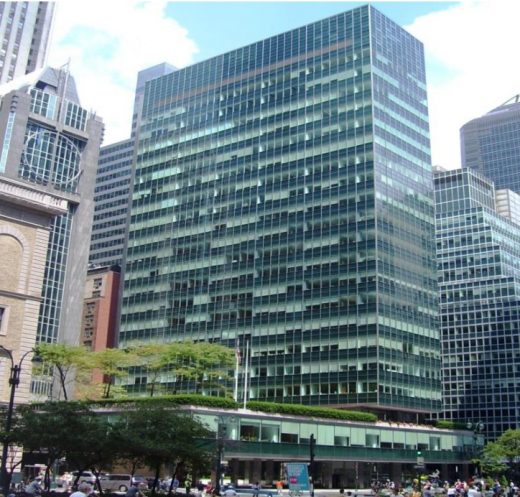
Fig1: Rigid Frame Structure
Courtesy: engineeringmeetsarichitecture-wordpress.com
A rigid frame structure can be divided into two categories:
i) Fix-Ended Rigid Frame Structure:
The conditions at the ends are usually set in this rigid frame system.
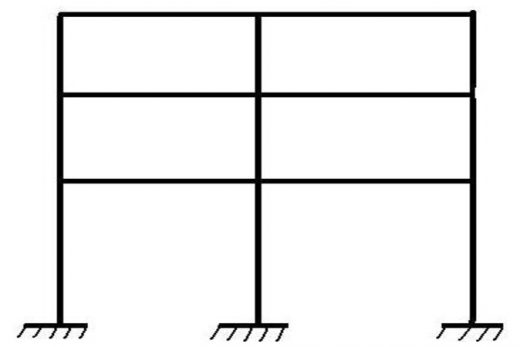
Fig2: Fix-Ended Rigid Frame Structure
Courtesy: engineeringmeetsarichitecture-wordpress.com
ii) Pin-Ended Rigid Frame Structure:
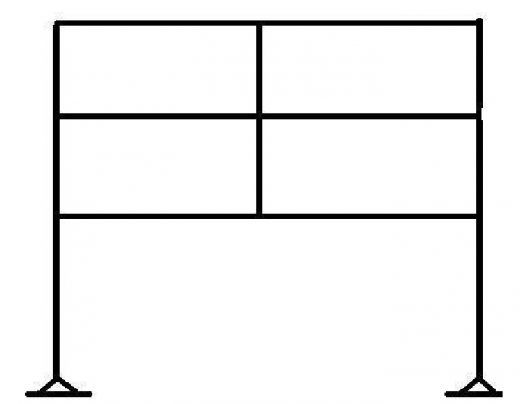
Fig3: Pin-Ended Rigid Frame Structure
Courtesy: constructionhow.com
This rigid frame is held together by pins and is no longer a rigid frame if the pins are removed.
2. Braced Frame Structure:
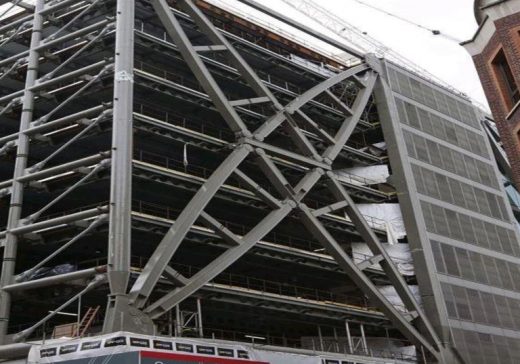
Fig4: Braced Frame Structure
Courtesy: structville.com
Bracing is typically installed between beams and columns in this frame system to strengthen the system’s resistance to lateral forces and sideways forces. Placing the diagonal elements between the beams and columns is a common bracing method. This skeleton design is more able to withstand earthquake and wind pressures. Compared to rigid frame systems, this one is superior.
A braced frame structure can be divided into two categories:
i) Portal Frames:
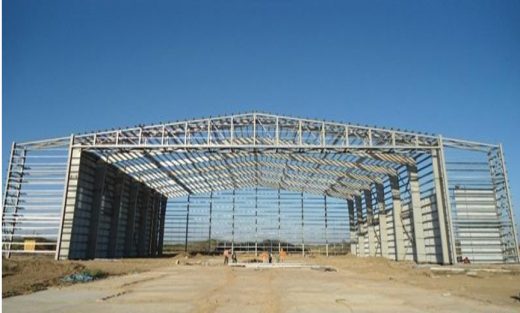
Fig5: Portal Frame Structure
Courtesy: en.wikiepedia.org
Most portal frames are designed to resemble doors. In the commercial and industrial sectors, this frame system is widely used.
ii) Gabled Frames:
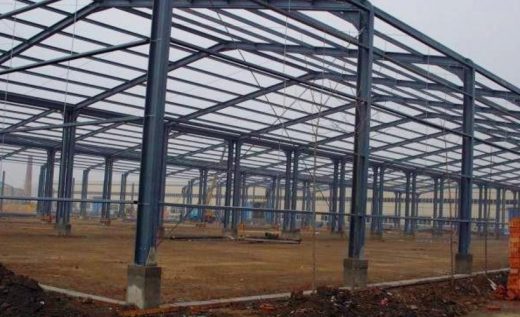
Fig6: Gable Frame Structure
Courtesy: en.wikiepedia.org
Most of the time, the peak is at the top. This type of frame is used where it might rain or snow a lot.
B. Based on the materials used for the frame structure:
i) Steel Framed Structures:
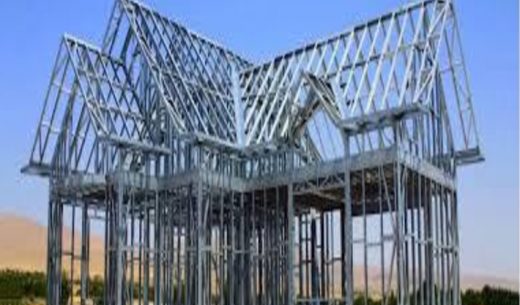
Fig7: Steel Frame Structure
Courtesy: buildersmart.in
A steel framework is used to carry the weight of these structures. Steel sections are used for these structures’ columns, beams, and girders. Bracing should be sufficient for these structures to withstand wind and seismic effects. Lightweight and fireproof materials are typically chosen for these structures’ interior and external walls. Steel-framed structures are, therefore, analogous to reinforced concrete structures (RCC).
Steel can support significantly more weight in the same area than any masonry can. It allows for greater column-free areas by reducing the columns required for beam support at regular intervals.
ii) Wooden Frame Structure:
The wood frame structure is one of the most popular methods for constructing homes, businesses, and factories. Wooden frames are highly cost-effective to construct and provide a high level of comfort to the inhabitants by withstanding extreme climatic variations. Moreover, wood frames are carbon-neutral and help reduce emissions of greenhouse gases.
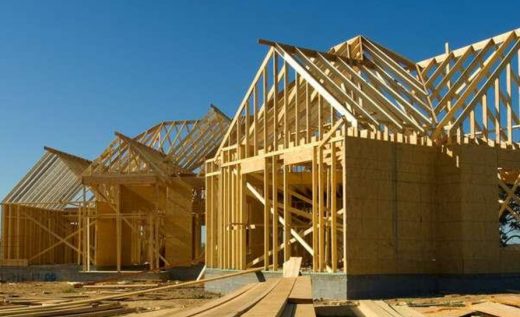
Fig8: Wooden Frame Structure
Courtesy: ecohome.net
When working with wood, there are no limits to the architectural possibilities that can be explored. Buildings made of wood can serve their intended purposes if they are constructed utilizing good building techniques and methods. For instance, the lightweight nature of wood frames reduces the need for expensive cranes and other heavy machinery during the erection process, helping to keep construction costs down.
iii) RCC Frame Structure:
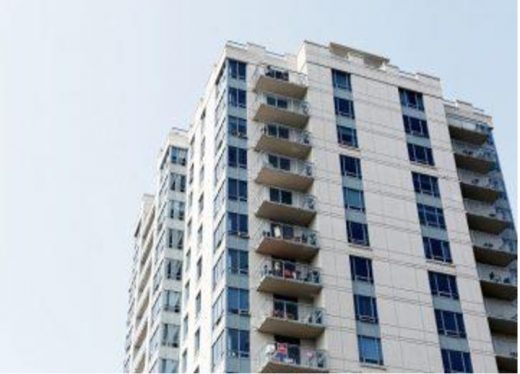
Fig9: RCC Frame Structure
Courtesy: getmeroof.com
An RCC structure has a grid of beams and girders connected at the floor and roof levels to create a series of frames. Within these frameworks, walls are built. All structural elements—the slab, the beams, the girders, and the columns—are constructed as one solid piece and meet at a stiff, unified junction. So, in a framed structure, the beams and girders take the weight of the floors, roofs, and walls and transfer it to the columns, which in turn transfer it to the foundations.
All RCC frames are built in a single, seamless piece to provide complete continuity between the columns, beams, and slabs (of floors and roofing). Buildings can be constructed more cheaply and safely with continuous construction thanks to decreased deflections and bending moments in the members.
Advantages of Frame Structure:
- The strength and stability of the structures have improved.
- The rigidity and stability of framed buildings are very high. Framed buildings can withstand large vertical (dead load) and horizontal (wind) loads, as well as earthquakes, without much deformation or movement.
- Buildings with multiple floors can also be made.
- Framing makes a structure less likely to shake. Framed structures can resist vibrations well, which makes them good for buildings in areas prone to earthquakes and industrial structures.
- The lack of large load-bearing walls and other factors keeps the dead load minimum.
- Every finished floor slab protects the lower floors from rain and sun.
Disadvantages of Frame Structure:
- Normal reinforced concrete limits span lengths in frame buildings to no more than 40 feet. Otherwise, spans greater than that can generate lateral deflections.
Conclusion:
A Frame structure uses beams, columns, and a slab to withstand lateral and gravitational loads. Typically, such structures are employed to counteract the resulting huge moments due to the imposed loading. Materials like rebar-strengthened concrete, steel, and wood are all good alternatives for constructing various frame structures.
References:
1. “Types of Frame Structures Rigid and Frame Structure – Construction How.” Construction How, 6 May 2020, constructionhow.com/types-of-frame-structures.
2. LCETED. “Framed Structures | Concept | Principles | Materials Used | Tall Buildings | Pre-Fabricated Buildings -lceted LCETED INSTITUTE FOR CIVIL ENGINEERS.” LCETED INSTITUTE FOR CIVIL ENGINEERS, 6 Aug. 2001, www.lceted.com/2021/08/framed-structures-concept-principles.html.
3. “Structural Components of Framed Construction | Bartleby.” Structural Components of Framed Construction | Bartleby, www.bartleby.com/subject/engineering/civil-engineering/concepts/structural-components-of-framed. Accessed 25 Oct. 2022.
4. “What Is a Frame Structure Building: Types and Advantages.” Real Estate Forum by NoBroker.com, 6 June 2022, www.nobroker.in/forum/what-is-frame-structure-building.
5. Struccore. “Types, Advantage and Disadvantages of Frame Structures | Struccore.” Struccore, 20 July 2016, struccore.com/2016/07/20/what-are-the-types-of-frame-structures.
6. “Different Types of Frame Structures – US Framing.” US Framing, 10 Dec. 2021, usframing.com/2021/12/10/different-types-of-frame-structures.
If you have a query, you can ask a question here.


